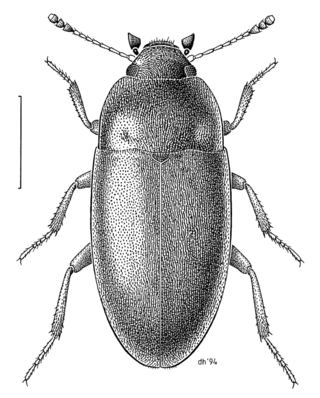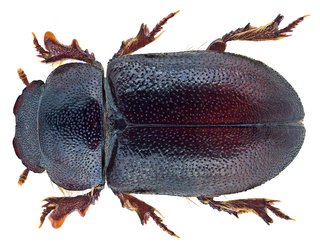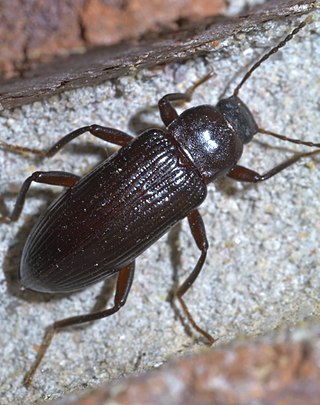
Johan Christian Fabricius was a Danish zoologist, specialising in "Insecta", which at that time included all arthropods: insects, arachnids, crustaceans and others. He was a student of Carl Linnaeus, and is considered one of the most important entomologists of the 18th century, having named nearly 10,000 species of animals, and established the basis for the modern insect classification.

Darkling beetle is the common name for members of the beetle family Tenebrionidae, comprising over 20,000 species in a cosmopolitan distribution.

The Tenebrionoidea are a very large and diverse superfamily of beetles. It generally corresponds to the Heteromera of earlier authors.

Zophobas atratus is a species of darkling beetle, whose larvae are known by the common name superworm, kingworm, barley worm, morio worm or simply Zophobas. Superworms are common in the reptile pet industry as food, along with giant mealworms.

The family Archeocrypticidae is a small group of beetles with no vernacular common name, though recent authors have coined the name cryptic fungus beetles. Adults and larvae seems to be saprophagous and are often found in plant litter. Worldwide, about 10 genera and 50 species are found, most species are pantropical. Enneboeus caseyi has been recorded from the American South, Central America, and Mexico. About 20 species are found in Australia, in the genera Enneboeus,Australenneboeus and Gondwanenneboeus,Archeocrypticus,Falsoplatydema, Nothenneboeus, Sivacrypticus and Wattianus. They are largely absent from the Palearctic and Nearctic regions.

Leiodidae is a family of beetles with around 3800 described species found worldwide. Members of this family are commonly called round fungus beetles due to the globular shape of many species, although some are more elongated in shape. They are generally small or very small beetles and many species have clubbed antennae.

Eleodes is a genus of darkling beetles, in the family Tenebrionidae. They are endemic to western North America ranging from southern Canada to central Mexico with many species found along the Mexico-United States border. Some species have been introduced to Colombia. The name pinacate is Mexican Spanish, derived from the Nahuatl (Aztec) name for the insect, pinacatl, which translates as "black beetle".

Tenebrioninae is the largest subfamily of the darkling beetles (Tenebrionidae), containing flour beetles, among others. Tenebrioninae contains more than 20 tribes.

Cheirodes is a genus of darkling beetles in the Melanimonini tribe. It was formerly known as Anemia until 1973, when T. J. Spilman determined Anemia to be a synonym of CheirodesGéné, 1839.

Lobopoda is a genus of comb-clawed beetles in the family Tenebrionidae. The type species is Lobopoda striata. The following subgenera of Lobopoda have been described:
Trachelostenus is a genus of darkling beetles in the family Tenebrionidae. It is native to the Valdivian forests of Chile, and has at least two species, T. inaequalis (Solier) and T. fascicularis (Philipp). It was historically considered the only member of the family Trachelostenidae, but a 2015 study sunk the genus into the tenebrionid subfamily Tenebrioninae.

The Sepidiini is a tribe of ground-dwelling darkling beetles (Tenebrionidae), that occurs across Africa, the Mediterranean Basin, the Arabian Peninsula and Mesopotamia. It is composed of many hundreds of species. The larvae of some species are known to damage crops.

Anomalon cruentatum is a species of parasitoid wasps belonging to the family Ichneumonidae.

Strongylium is a genus of darkling beetles in the family Tenebrionidae. It is one of the largest genera in the family and its subfamily Stenochiinae, with more than 1,400 known species which occur widely in the tropics and subtropics of the Old and New World. More than 300 species are native to the neotropics.

Lagriinae is a subfamily of long-jointed beetles in the family Tenebrionidae. There are more than 270 genera in Lagriinae, grouped into 11 tribes.
Aphanotus brevicornis, the North American flour beetle, is a species of flour beetle in the family Tenebrionidae. It is a pest of stored foodstuff, particularly processed grains.

Gonocephalum depressum is a species of darkling beetle. The species is widespread in South Asian and South East Asian countries such as, India, Bhutan, Nepal, Pakistan, Indonesia, Laos, Philippines, Sri Lanka, Myanmar, Taiwan, Afghanistan and China.

Blaptinae is a subfamily of darkling beetles in the family Tenebrionidae. There are around 300 genera in Blaptinae, divided into 7 tribes.
Boromorphus is a genus of darkling beetles in the family Tenebrionidae. There are at least four described species in Boromorphus, found in the Palearctic. It is the sole genus in its tribe, Boromorphini.
Gonocephalum sericeum is a species in the darkling beetle family Tenebrionidae. It is native to North Africa and the Middle East, and is advantive in North America. It has been established in California since at least 1980.
















